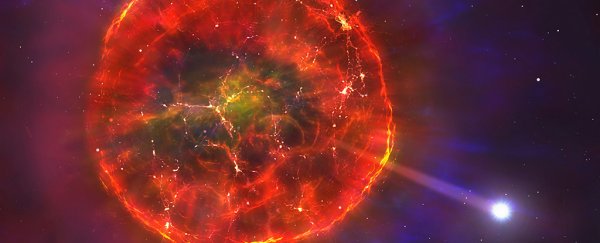The cosmic object we've called LP 40-365 and presumed to be a star up until now, is not actually a star.
Or rather, it's not a whole one. Astronomers have determined it's a piece of star shrapnel, left over when a more massive star experienced a catastrophic supernova.
That explosion was so powerful, it punted LP 40-365 out into interstellar space with such a kick that it's on target to leave the Milky Way entirely, having achieved sufficient velocity to escape the galaxy's gravity well.
It's travelling at the breakneck speed of around 852 kilometers per second (529 miles) - a rare beast known as a hypervelocity star. And astronomers have discovered that LP 40-365 is rotating, giving us an indication of the explosion that produced it.
"To have gone through partial detonation and still survive is very cool and unique, and it's only in the last few years that we've started to think this kind of star could exist," said astronomer Odelia Putterman of Boston University.
Most hypervelocity stars in the Milky Way tend to be dead ones, like white dwarfs and neutron stars. That's because they're the most likely to experience events violent enough to propel them out into space; in the case of dead stars, that's generally supernova explosions.
Working out how that explosion went down then requires a bit of detective work. With LP 40-365, the team used data from the Hubble Space Telescope and NASA's exoplanet-hunting telescope TESS to take a closer look at the star remnant itself.
TESS, because of the way it finds exoplanets, is optimized to detect brightness variations in stars - and this is what the team found with LP 40-365. Every 8.9 hours, its brightness changed.
"We dug a little deeper to figure out why that star [was repeatedly] getting brighter and fainter, and the simplest explanation is that we're seeing something at [its] surface rotate in and out of view every nine hours," said astronomer JJ Hermes of Boston University.
In and of itself, that's not peculiar. All stars rotate. But an 8.9-hour rotation for a star that's been booted across the galaxy by a supernova seems oddly slow. The researchers were able to use this to reconstruct information about how the supernova occurred.
We know, based on previous research, that LP 40-365 was likely once part of a binary containing a high-mass white dwarf, probably clocking in at around 1.3 times the mass of the Sun. That's very, very close to a critical mass called the Chandrasekhar limit, which is around 1.4 times the mass of the Sun. If the white dwarf gains any more mass than this, it becomes unstable, and usually goes spectacularly kaboom in what is known as a Type Ia supernova.
They gain this mass by slurping it off a binary companion star, orbiting closely enough that its outer material is siphoned off by the white dwarf's gravity field. Many white dwarfs have binary companion stars; LP 40-365, its composition and velocity both suggest, was once part of just such a binary.
The velocity is obvious, because there are very few known mechanisms that can produce such high-speed stars. And the star's composition is highly metallic. Since we know that supernova explosions produce heavy elements, the metallicity, combined with the velocity, makes a supernova the most likely origin.
LP 40-365 now clocks in at a lightweight 0.14 times the mass of the Sun. It's difficult to gauge, however, whether it was part of the original white dwarf in the binary, or the companion star - slurper or slurpee. This is what the rotation rate of the star can help reveal.
By performing calculations based on this rate, and using estimated masses of the white dwarf and its companion, the researchers were able to determine that LP 40-365 was indeed very probably once part of the slurping white dwarf.
It's on an escape trajectory and will leave the galactic disk in about 5.3 million years.
What happened to the other star is anyone's guess - it likely also got punted away, but in another direction. It could be anywhere by now. But identifying LP 40-365 can help us better understand how these energetic events occur, how they produce heavy elements, and the properties of their stellar shrapnel.
"This adds one more layer of knowledge into what role these stars played when the supernova occurred," Putterman said.
"By understanding what's happening with this particular star, we can start to understand what's happening with many other similar stars that came from a similar situation."
The research has been published in The Astrophysical Journal Letters.
